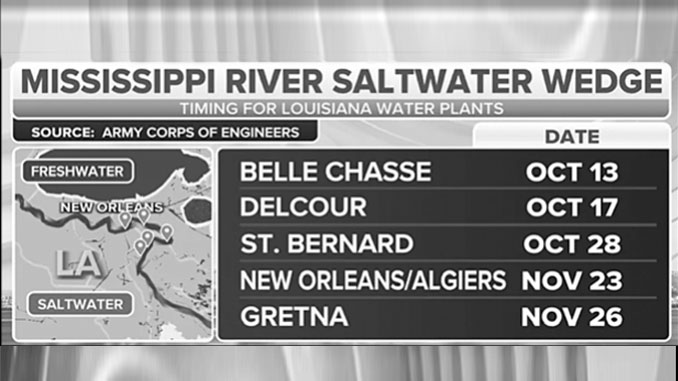
Data News Staff Edited Report
Salt water inching up the Mississippi River from the Gulf of Mexico is progressing more slowly than projected, authorities said Thursday, meaning water systems in the Greater New Orleans area that draw drinking water from the river have additional weeks to prepare.
For some small systems downriver, the projected arrival of salt water was pushed back to later this month. For New Orleans and neighboring Jefferson Parish, the threat to water system intakes was pushed back from late October to late November. And intakes for large portions of the city and Jefferson Parish now are not expected to see salinity above 250 parts per million, a level that triggers health warnings.
Unexpected October or November rains could further delay and diminish the threat, said Col. Cullen Jones, Commander of the U.S. Army Corps of Engineers’ New Orleans District.
Typically, the Mississippi’s flow is sufficient to prevent salt water from moving farther upstream. But for the second year in a row, hot and dry weather has lowered the river, allowing a denser, heavier layer of salt water from the Gulf to push inland.
State, local and federal officials discussed the latest projections at a news conference at the Corps’ New Orleans Headquarters. Jones cited two factors in the latest projections: an underwater sill downriver has succeeded in impeding the heavy salt water’s flow upriver; and weather and river forecasts, while still showing a continued drop in the river’s usual downriver flow, are more optimistic.
Recent Stories from ABC News
Salt water that overtops the underwater sill is still lower in salinity than the water behind the sill toward the Gulf, Jones said.
“This updated projection is clearly a relief to all of us,” said Collin Arnold, New Orleans’ Emergency Director.
Salt water already has reached some Plaquemines Parish communities closer to the river’s mouth — Boothville, Port Sulphur and Pointe a la Hache. But communities such as Belle Chasse, Dalcourt and St. Bernard have gained another week or two to prepare. In the immediate New Orleans metro area, people who had been told their systems would be threatened by late October saw projections pushed back to Nov. 23rd and beyond.
Officials said multiple efforts to provide safe water to the downriver systems continue, including barging large amounts of fresh water to the intakes and installing better filtration systems. For the heavily populated parts of New Orleans and neighboring Jefferson Parish, where barging water is not practical, plans continue for pipelines to shunt fresh water from farther upriver.
For New Orleans alone, the pipe system costs have been projected at $150 million to $250 million. Local and state authorities expect much of the cost to be covered by the Federal Government. President Joe Biden said late last month that Federal Disaster Assistance would be made available to Louisiana.
Recommended For You.
















Be the first to comment